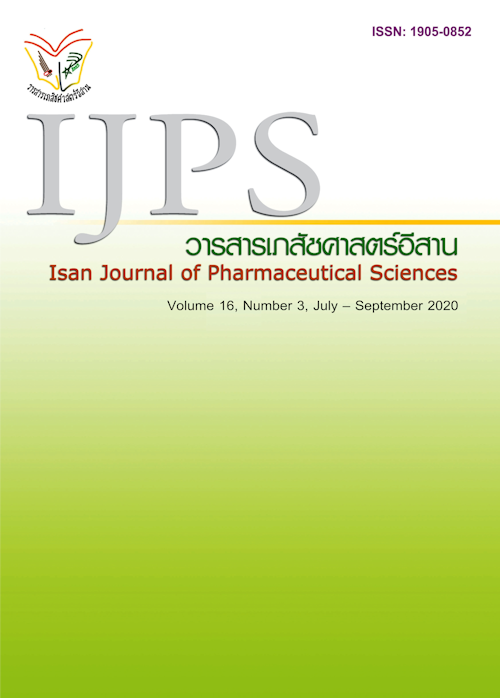The study of preparing errors by pharmacy robot and various electronic drug cabinet in hospitalized patients at Srinagarind Hospital
Main Article Content
Abstract
Medication errors can cause a harmful treatment to patients. Objective: To compare rate, severity level, type and causal factors of preparing errors between Pharmacy robot, Semi-Automatic Medication Dispenser Station (LED cabinet), High alert drug Medication Cabinet (HAD cabinet) and manual picking in hospitalized patients. Method: This study was a retrospective descriptive study. Reports of predispensing and dispensing errors in wrong preparing process were collected in inpatients pharmacy service unit at Srinagarind Hospital by pharmacists and medical staffs. Data were collected between 1st July 2018 and 30th June 2019. The data for causal factors were collected by using fishbone diagram from brainstorming results. Results: Medication were prepared by pharmacy robot 255,969 items, LED cabinet 711,313 items, HAD cabinet 42,632 items and manual picking 1,137,194 items. The pharmacy robot had the least incidence of preparing errors, followed by HAD cabinet, LED cabinet and manual picking (0.63, 1.17, 7.54 and 9.16 errors per 10,000 prescriptions), respectively. Incidence rate of preparing errors were statistical difference (p < 0.001); pharmacy robot had 1,355.24% error less than manual picking, pharmacy robot had 1,096.83% error less than LED cabinet. However, the pharmacy robot was less error than HAD cabinet 87% with no statistical significance. The severities of preparing errors were found statistical difference only in level B. (p < 0.001). The type of preparing errors by manual picking and LED cabinet were wrong drug, strength, dosage form, amount, person, lacking of medicine and swapping of medicine bag. Pharmacy robot and HAD cabinet found only wrong drug and amount. The product defected were found only in pharmacy robot. Human errors and drug factors were the most effect for preparing errors in manual picking, especially the drug which have look alike and sound alike. Prescription and drug label factor were the most effects for preparing errors in LED cabinet. Equipment factor was the most effect for preparing errors in pharmacy robot and LED cabinet. Conclusion: The pharmacy robot caused the least incidence of preparing errors, followed by HAD cabinet, LED cabinet and manual picking in hospitalized patients. Hence, the technology can be come an essential tool to reduce the cause of human error and look-alike sound-alike problems.
Article Details
In the case that some parts are used by others The author must Confirm that obtaining permission to use some of the original authors. And must attach evidence That the permission has been included
References
Chanatepaporn, P. Efficacy and Safety of Dispensing System by Pharmacy Robot and Handset Electronic Picking in Hospitalized Patients at Srinagarind Hospital. Srinagarind Med J 2020; 35(3): 311-9.
Chantapattarankul P. Medication Error of In Patients Pharmacy Department at Bangsaphan Hospital, Prachuap Kirhikhan. Hua Hin Sook Jai Klai Kangwon Journal 2017; 2(2): 17-22.
Chumchit C. Development of medication safety management system for look-alike soundalike drugs in public hospitals. [Dissertation]. Nakorn Pratom: Silpakorn University; 2013.
Goundrey-Smith S. Pharmacy robots in UK hospitals: the benefit and implementation issues. Pharm J 2008; 280: 599-602.
Juran JM, Bingham FS, Gryna FM, Quality Control Handbook, 3rd ed. New York: McGraw-Hill; 1974.
Khrueawang K. Medication Error. Public Health & Health Laws Journal 2018; 4(2): 251-65.
Lehnbom EC, Oliver KV, Baysari MT, Westbrook JI. Evidence briefings on-interventions to Improve medication safety. Centre for health systems and safety research [serial online] 2013 [cited 2020 Feb 24]; 1(2): [4 screens]. Available from: https://www.safetyandquality.gov.au/sites/default/files/migrated/Evidence-briefings-on-interventions-to-Improve-medication-safety-Automated-dispensing-systems-PDF-832KB.pdf
National Coordinating Council for Medication Errors Reporting and Prevention. NCC MERP Taxonomy of Medication Errors. [cited 2020 Feb 24]: [19 screens]. Available from: http://www.nccmerp.org/sites/default/files/taxonomy2001-07-31.pdf
Ong YSP, Chen LL, Wong JA, et al. Evaluating the Impact of Drug Dispensing Systems on the Safety and Efficiency in a Singapore Outpatient Pharmacy. Innov Pharm 2014; 5(3): 1-7.
Plodkratoke W, Kittisopee T, Sakulbumrungsil R, Reungjarearnrung K. Cost Saving and Cost Avoidance of the Pharmacy Automation. TJHP 2010; 20(1): 43-54.
Rodriguez‐Gonzalez CG, Herranz‐Alonso A, Escudero‐Vilaplana V, Ais‐Larisgoitia MA, Iglesias‐Peinado II, Sanjurjo‐Saez M. Robotic dispensing improves patient safety, inventory management, and staff satisfaction in an outpatient hospital pharmacy. J Eval Clin Pract 2019; 25: 28–35.
Rurgchaisri S, Sitakalin P, Keerapong P. Causal Factors Related to Medication Errors in Community Pharmacy Department in Phra Nakhon Si Ayutthaya Province. JPMAT 2016; 6(3): 225-30.
Somchai P, Sukon P, Sornsena S. The Comparison of Medication Errors Before and After the Development of Medication Safety System. TJHP 2007; 17(2): 100-8.
Temple J and Ludwig B. Implementation and evaluation of carousel dispensing technology in a university medical center pharmacy. Am J Health-Syst Pharm 2010; 67: 821-9.
Tewthanom K and Tananonniwas S. Medication error and Prevention guide for patient’s safety. Veridian E-J. sci. technol. Silpakorn Univ 2009; 2(1):195-217.
Varzakas TH. Application of ISO22000, Failure Mode, and Effect Analysis (FMEA) Cause and Effect Diagrams and Pareto in Conjunction with HACCP and Risk Assessment for Processing of Pastry Products. Crit Rev Food Sci Nutr 2011; 51(8): 762-82.


